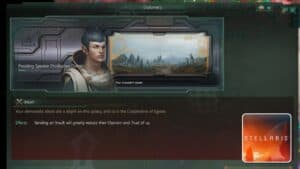There is every chance that this guide could be the most valuable piece of content you ever read about Stellaris. Technology is king in Stellaris, and the key to ascending from an average player to a great player comes from using the tech system to your advantage.
Stellaris is about creating a cool space empire that creates marvels of engineering that, to us, may as well be magic. To create that amazing technology, your scientists will first need to research it.
Recommended Read: How to Build an Orbital Ring in Stellaris
If you neglect your empire’s technology advancement, it will not take long for your neighbors to overtake you. When they do that, it is only a matter of time before their superior weaponry becomes your biggest problem.
This guide is going to teach you everything you could ever want to know about how technology and research work in Stellaris.
Good technology is the most important key to victory in Stellaris. Your scientists spend your empire’s research points on new technology projects. After you spend enough research points, you unlock that technology, and your scientist can move on to the next project.
Table of Contents
- Technology Introduction
- What is Technology and Research in Stellaris?
- How the Game Allocates Technology Projects
- What Technology Should You Research?
Technology Introduction
“Tech rush,” “prioritize research,” “out-tech them”; these are terms you may read if you ever browse a Stellaris forum.
They more or less mean the same thing, having great technology is one of the most effective strategies to winning Stellaris.
Getting ahead in the technological cold war is the most effective strategy to boost your empire in Stellaris.
Having a booming economy is great, but if you can only equip your ships with pea shooters and your enemy has massive lasers, who is winning that fight?
Technology is the answer to almost every problem that can crop up in the game: it improves your economy, combat effectiveness, pop growth, pop happiness, allows terraforming, unlocks new ships, helps you make allies, better weapons, and anything else you can think of.
If you have a problem, there is, without a doubt, a research project that can help.
At its core, the research system is simple: the game offers you some projects, you select one, your scientists research it, you unlock the tech, and then pick another one.
Under the hood of that basic mechanic, there is a lot going on. It does involve some complicated background math and a random draw element.
Don’t worry. You don’t need to understand the math to become efficient with this system and isn’t covered in this guide.
What is Technology and Research in Stellaris?
Technology is the catch-all term used for all the projects you unlock in the game.
From basic weapons all the way to gargantuan megastructures. Technology is then split into three different research fields.
These fields are: Physics Research, Society Research, and Engineering Research. These three fields are split into a further 13 sub-categories as follows:
- Physics Research:
- Computing: These unlock point defense systems, science ship upgrades, ship computers, new science labs, and improve research speed
- Field Manipulation: Technologies in this field involve shields, power production, and strategic resources
- Particles: Ship power systems, energy weaponry, strategic resources, and jump drives rely on particle research
- Society Research:
- Military Theory: More ship capacity, extra fleet command, bigger armies, military upgrades, and claim upgrades all stem from this field
- New Worlds: Speaks for itself but tile clearance, terraforming of planets, and improvements to habitability come from this research branch
- Biology: If you want longer living leaders, more food, new army types, and ways to modify your species; biology projects are the place to go
- Statecraft: improves edicts, unity production, better leader recruitment, and improves interactions with other space empires
- Psionics: A very niche field, only unlocked through your species unlocking their psionic potential
- Archaeostudies: All about the minor artifacts system, and the use of archaeo research technology projects
- Engineering Research:
- Voidcraft: You want the biggest and best ships right? Voidcraft is where you find them, as well as starbase upgrades and hull technology
- Materials: Armor and resource boons are yours for the taking, whenever you commit your research to this field of study
- Industry: This section is for mineral production, resource storage, robot building, and unlocking new planetary buildings
- Propulsion: New engines for your ships, and exotic weapon types become available to you when you work on propulsion projects
How the Game Allocates Technology Projects
Stellaris forgoes a linear tech tree system, for what it calls the card system. To understand it, you need to use your imagination a bit.
Think of every single technology project in the game as a playing card. Every technology your empire can begin researching, gets referred to as the technology deck.
So the “deck” is all possible projects, and a “card” is one individual project.
When it comes time to select a card, the game shuffles the deck and deals you three cards.
You select one of these, and when your scientists finish the work, the game deals you three new cards to pick from.
Please bear in mind, the deck is invisible to players, and there is no way to inspect what cards are in there.
Simple enough so far? Well, it gets more complicated from here on out.
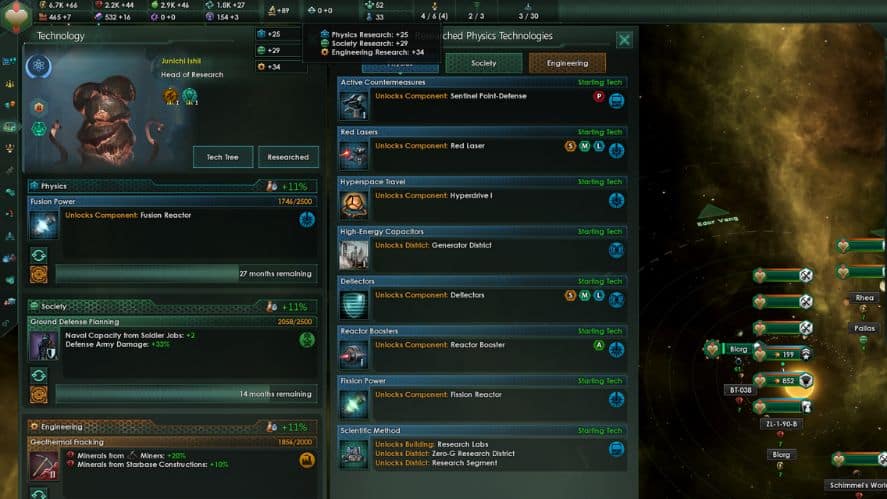
Every card has a tier allocated to it, from zero to five. The higher the tier, the higher the cost and the more advanced the technology is.
At the start of the game, you will only have access to tier zero and tier one technology cards.
To unlock the next tier, you need to unlock six technologies from the tier that comes before it.
This means to get tier two cards, you first need to research six different tier one cards. This pattern continues for all later tiers.
Once you do that, all the tier two technologies that you meet the prerequisites for get added to the technology deck as potential draws.
But wait, there’s more. The chance of drawing a specific card is not equal. The game uses something called the weighting system.
This system gives makes it more likely that certain cards appear and decreases the chance of others.
Weight depends on a lot of factors: ethics, whether the card has already appeared before, if your allies have the technology unlocked, the tier of the card, whether the technology is rare, and scientist traits.
Research Alternatives
By default, whenever you receive your hand of cards to pick from, you only get three cards.
You can increase that amount by +1 with the following sources:
- Self Evolving Logic technology
- Technocracy civic
- Natural Neural Network civic
- Static Research Analysis civic
- Science Division tradition
- Mindlink tradition
- Research Path Optimization tradition
- Ruler having the Erudite trait
- Settled Differences empire modifier
You will not be able to have all these for your empire because these options are not available to everyone.
It is not uncommon by the end of the game to have around three of these. Meaning every time you select a research project, you enjoy three extra cards to choose from, for a total of six.
There is one final way to obtain research alternatives, named the permanent alternatives. These appear below the hand of cards dealt to you.
You can tell they are permanent because they have a golden border, and the project will already be partially completed.
These permanent alternatives come from scanning space debris, special projects, or in-game events.
They will always be available on top of the normal research alternatives dealt to you. This could result in you having many research projects to choose from, well over your research alternatives cap.
With that explained, it is time to learn how the technology gets researched.
What do Research Points do
The short version is: the more research points you have, the faster you can research technology. A more detailed explanation than that is as follows.
Your scientists will spend all the available research points on the technology they are researching. Research points are separated into the three fields of research: Engineering, Society, and Physics.
You can see your monthly research production at the top of the interface by highlighting the picture of a microscope.
You can use this number to work out how long a project will take. Every project has a research cost.
Let’s say you have a technology that costs 2000 engineering research. Also, your empire produces 100 engineering research a month.
If you take the cost and divide it by the monthly research production, it will give a pretty decent estimate of how long the project will take.
In this case, it is 2000 ÷ 100 = 20. So that project would take around 20 months to complete.
The cost for the technology goes up the higher the tier, and it scales with empire size.
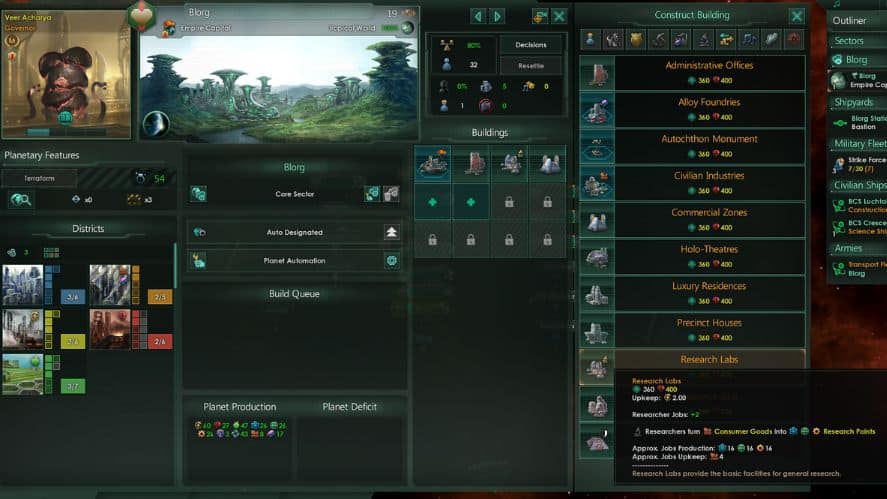
You can get more research points from the following sources:
- Researcher jobs on planets
- Building research stations in space
- Stacking research speed bonuses e.g. edicts, scientist traits, or the curator enclave deal
- Entering into Research agreements with other empires
- Scanning debris after space battles
What Technology Should You Research?
The one million energy credit question that everyone wants to know. What are the best technologies to research in Stellaris?
The easy answer would be whatever your empire needs at the time to overcome its current challenges.
Due to the semi-random nature of Stellaris’s technology tree, this advice is pretty rubbish.
If you follow five key principles for selecting a research project, you will not be far off from taking the optimal path.
Rule Number One – Read the Damn Tech Card
Research is king in Stellaris, and being competent with the research system will make you a good player.
The path to true greatness relies on the player’s ability to read the information the game gives them.
Seriously, if you take the time and read what the game puts in front of you, your power level in this game becomes limitless.
Instead of looking at the name and picture of the project, learn what it does and see if it is useful to you.
For example, let’s pretend the game offers you x-ray lasers as a research project. Man, don’t those sound cool? Your ships would be awesome with those on. Wrong, your enemy uses a lot of shields, and lasers do reduced damage to shields.
Researching these projects now could tie up your scientist for years. The game has a pause function. Use it and take time to make the correct choices.
Rule Number Two – Research Research
There are loads of research projects that provide bonuses to specific game mechanics. There are ones that increase ship fire rate, mining production, ship speed, etc.
The most valuable of these are research projects that increase your research speed. The earlier you can get these, the better.
Some of these provide very generous modifiers, and the sooner you can make use of them, the better.
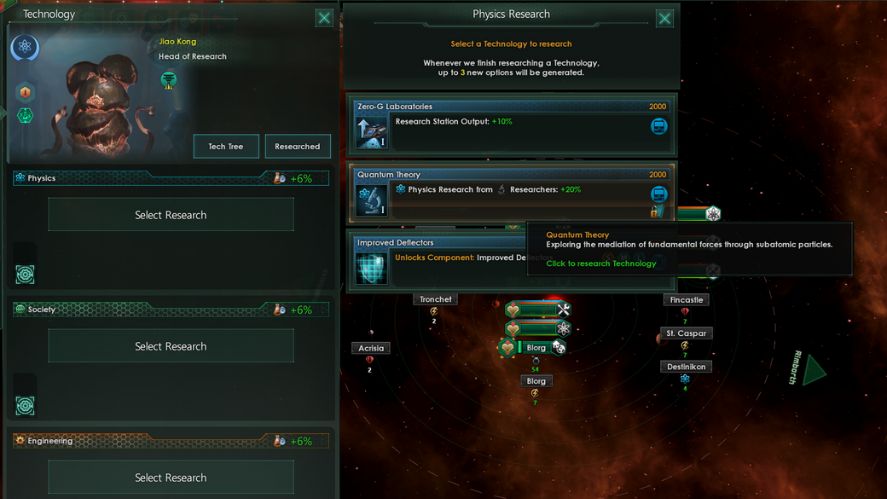
Over a full game, these research projects could save your researchers decades of work. What is even better, as the game proceeds, the value of these technologies increases with your research production.
If increasing your research speed is ever presented to you, it should be high on your target list.
Rule Number Three – If All Options Suck, Take the Cheapest
There are a lot of winner technologies in the game. The problem is there are a lot of losers out there as well.
At one point in your Stellaris career, the game is going to present you with nothing but rubbish. It is rare, but it does happen, but there is one thing you can do to help.
Earlier in the guide, we discussed that when a project is complete, the game reshuffles the deck and deals you some new cards to choose from.
Well, you need to get that to happen as soon as possible. You do that by picking the subpar technology that has the lowest cost.
It does suck to have to lose time on research. Excuse the pun here, but you have to play the hand you are dealt. Picking the cheapest project could get you back on track, potentially years before picking a more expensive option.
Rule Number Four – If it is Rare, Pick it
Rare technologies are the best ones in the game. They are the key to megastructures, super bonuses, powerful weaponry, and all the other cool stuff you want.
While they are all not S-tier technologies, a good rule of thumb is that they are probably better than your other choices.
But, if you are applying rule number one, then you will know when to not apply this rule.
This rule is very vital earlier in the game. If you are lucky enough to receive rare technology early, you need to pounce on that and start reaping the rewards.
You will know a rare technology, as the card display will have a purple border.
Rule Number Five – Avoid Repeatable Technologies Until you Have no Choice
Toward the end of the game, the game will begin presenting you with repeatable technology projects.
These are expensive, provide a minor benefit, and can be repeated infinitely. These techs are great when you have no other choice but to take them.
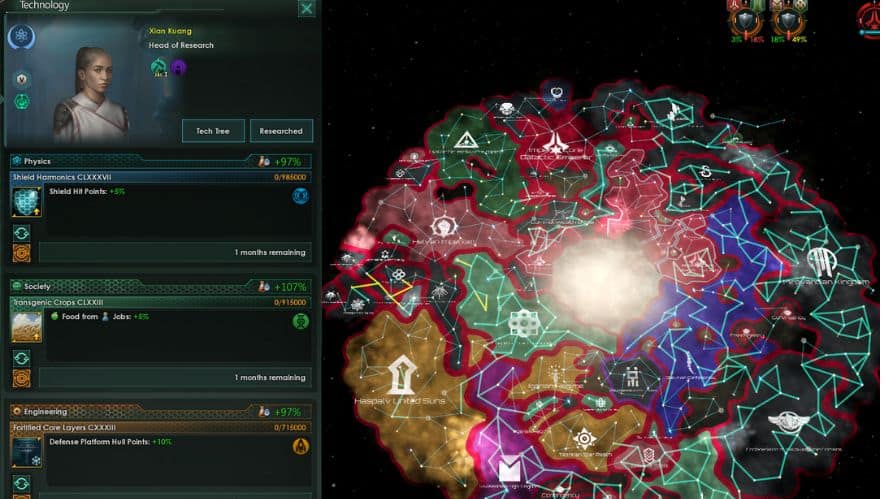
They become so expensive and lock up your resource points for long periods of time. This time could be better used for the final weapons upgrades your ships need or unlocking a super powerful megastructure.
Do yourself a favor and save the repeatable technologies for when you have finished all the other research projects.
These techs signify the end of research being something to worry about. Set your scientists to auto-research, and let them work at these until the game ends.
This is everything you need to know about technology in Stellaris.
As mentioned at the beginning, this guide is one of the most important ones you will ever read. So please, take extra time to digest the information contained within.
We encourage you to ask questions and make suggestions in the comments section as well. As always, have fun researching all the best technology in Stellaris.



